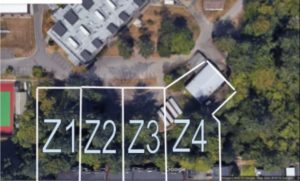The 2017-18 School Year is the 2nd year of our NOAA sponsored “Climate Resiliency Fellows” Program. Our aim is to “Create a dynamic community of informed teachers committed to involving their students in learning about and engaging in local climate change issues and climate resiliency projects.” Many thanks to all of our hard working teachers and students!
Carbon Sequestration at Capital High School
This past semester, Capital High School’s Environmental Science class worked with John Hayes, the current director of Mt. Rainer Institute, to calculate the amount of carbon sequestered on a 1.78 acre portion of the Capital High School campus.
What is Carbon Sequestration?
Carbon Sequestration is a process in which carbon is removed from the atmosphere by several different processes. In terms of trees, carbon can be removed from the atmosphere through the process of photosynthesis. The plant cells in the trees change the carbon from CO₂ to solid carbohydrates and sugars that are stored in leaves, roots, and other parts of the tree, helping the tree store energy and grow. Next, oxygen is put back in the atmosphere through this process of photosynthesis.
Carbon sequestration is an extremely important process (natural or human-based) in supporting ecosystems and reducing/equalizing carbon dioxide outputs. Also, it is important that the carbon cycle is balanced, and that the rate of carbon removed from the atmosphere is fairly close to that which is released through carbon sequestration. As of now, our carbon cycle is not balanced because of human interactions with the environment. The carbon cycle is the process of carbon compounds becoming converted into the environment, incorporating carbon dioxide into plants by photosynthesis and other processes.
Several major factors contributing to this unbalanced system is the burning of fossil fuels in industry and cars/vehicles. An increase of CO₂ in the atmosphere is leading to increased global warming, which is highly contributed to by the greenhouse effect. The picture below demonstrates the carbon cycle in action, and how CO₂ moves throughout an ecosystem in different ways, recycling itself in the process.
Why Is This Important?
The carbon sequestered in trees is important for the ecosystem because it absorbs the CO₂ from the atmosphere to slow down the process of global warming and provide oxygen for all living organisms. In fact, most carbon is not sequestered by trees, but actually through several other processes that take place. Other methods of Carbon Sequestration include oceanic and geological processes, such as through the water cycle and rock interactions, organisms in the ocean, and soils. Without a way to sequester carbon, the carbon cycle and levels of CO₂ in the atmosphere would be even more out of balance than it is now.
It is extremely important that we find a way to attempt to equalize these levels, and utilize the many methods of sequestering carbon.
Our Area:
In order to perform our carbon sequestration calculations, we needed to split our research area into specified zones for each classmate to calculate. Our first zone, Z1, has 22 trees. Z2 has 17, Z3 has 16, and Z4 has 21 trees. Most of the trees in the area were evergreen softwood trees, such as Douglas Fir and Western Red Cedar. However, trees such as Red Alder and Big Leaf Maple also were included in the calculations.


